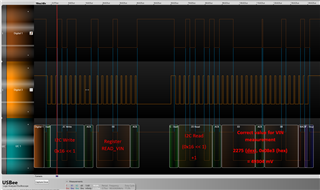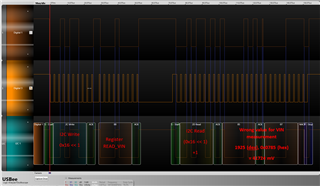Other Parts Discussed in Thread: LM5066
Hello TI experts!
I have a board with a DCDC converter with adjustable output voltage and three LM5066i, each can enable one different output. The circuit of theses are mostly identically with the circuit in the datasheet and only differ in terms of I2C address and UVLO resistors. These three LM5066i are managed by one STM32 and communicate via I2C. I'm now having a problem when reading the value of the register READ_AVG_VIN (DCh) or READ_VIN (88h) as soon as the enable pin (pin 7, UVLO/EN on LM5066i) is set to a high value.
When a voltage of less than ~41 V is applied to the three LM5066i, it is measured correctly no matter if any of the LM5066i is enabled or not.
When a voltage of more than ~41 V is applied to the three LM5066i, it is measured correctly on two of the LM5066i, no matter if enabled or not.
When a voltage of more than ~41 V is applied to the three LM5066i, it is always measured wrong on the same LM5066i (I2C address 0x16) as soon as the enable signal is set. This means, that the measured value always shows ~41 V, even when the actual voltage is higher.
I tried different boards with same assembly and same firmware and some do show this behavior, some not.
Measured value in register READ_AVG_VIN on board 1 (with error):
| LM5066i (0x16) | LM5066i (0x15) | LM5066i (0x50) | |
| ~41 V voltage, no LM5066i enabled | ~41 V | ~41 V | ~41 V |
| ~41 V voltage, any LM5066i enabled | ~41 V | ~41 V | ~41 V |
| ~49 V voltage, no LM5066i enabled | ~49 V | ~49 V | ~49 V |
| ~49 V voltage, LM5066i (0x15) or (0x50) enabled | ~49 V | ~49 V | ~49 V |
| ~49 V voltage, LM5066i (0x16) enabled | ~41 V | ~49 V | ~49 V |
Measured value in register READ_AVG_VIN on board 2 (without error):
| LM5066i (0x16) | LM5066i (0x15) | LM5066i (0x50) | |
| ~41 V voltage, no LM5066i enabled | ~41 V | ~41 V | ~41 V |
| ~41 V voltage, any LM5066i enabled | ~41 V | ~41 V | ~41 V |
| ~49 V voltage, no LM5066i enabled | ~49 V | ~49 V | ~49 V |
| ~49 V voltage, LM5066i (0x15) or (0x50) enabled | ~49 V | ~49 V | ~49 V |
| ~49 V voltage, LM5066i (0x16) enabled | ~49 V | ~49 V | ~49 V |
This problem only occurs on some boards and LM5066i devices and I was not yet able to track it down completely. My first guess was that custom register settings have been made on the affected LM5066i. But then again, I do not know which settings are stored in an non volatile memory on the LM5066i and I also do not see any settings that might modify the measurement or calculation of the voltage measurement depending on the state of the EN-pin.
Any ideas?
Best regards,
Christian Wächter




